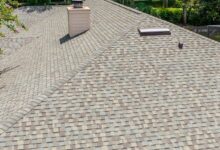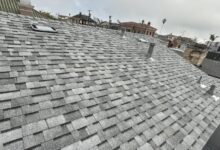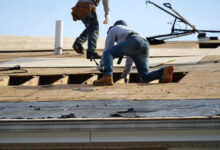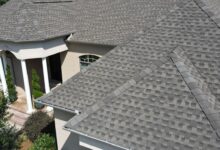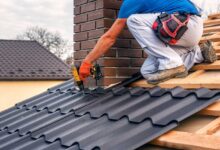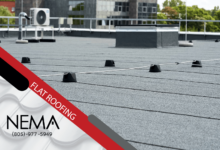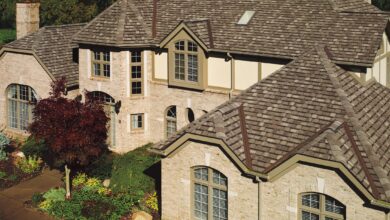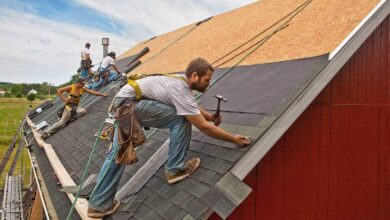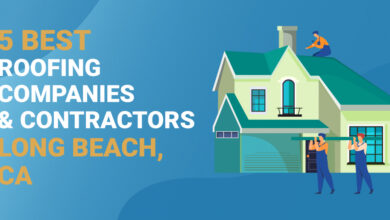Residential Roof Contractor: Your Guide
Residential roof contractors are essential for maintaining the integrity and longevity of your home. Finding the right contractor involves careful consideration of their qualifications, experience, and the services they offer. This guide navigates the complexities of choosing, working with, and maintaining your roof, ensuring a smooth and successful project from initial consultation to final cleanup.
From understanding the different roofing materials available, such as asphalt shingles, tile, and metal, to navigating the costs associated with repairs or replacements, this resource provides a comprehensive overview of the entire process. We’ll cover everything from obtaining multiple quotes and verifying credentials to understanding the stages of a roofing project and preventative maintenance strategies to extend your roof’s lifespan.

Defining the Ideal Residential Roof Contractor
Choosing the right contractor for your residential roofing project is crucial for ensuring a durable, safe, and aesthetically pleasing outcome. A poorly executed roofing job can lead to costly repairs, structural damage, and even safety hazards. Therefore, understanding the key characteristics of a reputable contractor is paramount.
Characteristics of a Highly Reputable Residential Roof Contractor
A highly reputable residential roof contractor consistently demonstrates professionalism, expertise, and a commitment to customer satisfaction. This includes clear and transparent communication throughout the entire process, from initial consultation to final project completion. They provide detailed estimates and adhere strictly to agreed-upon timelines and budgets. Furthermore, a reputable contractor prioritizes safety, employing proper safety measures on the job site and ensuring all work complies with building codes and industry best practices. They also maintain a clean and organized work area, minimizing disruption to the homeowner’s property. Finally, they stand behind their work, offering warranties and guarantees to address any unforeseen issues that may arise after the project is complete.
Essential Qualifications and Certifications
Homeowners should verify that their chosen contractor possesses the necessary qualifications and certifications to perform roofing work competently and legally. This includes verifying their state licensing, which ensures they have met specific requirements for competency and insurance. Additionally, seeking contractors with certifications from reputable organizations, such as the National Roofing Contractors Association (NRCA), demonstrates a commitment to professional standards and ongoing training. These certifications often indicate adherence to specific safety protocols and the use of quality materials. Checking for positive reviews and testimonials from past clients can further validate the contractor’s expertise and reliability. For example, a contractor certified by the NRCA has demonstrated proficiency in various aspects of roofing, including installation, repair, and maintenance.
Importance of Insurance and Licensing for a Residential Roof Contractor
Insurance and licensing are crucial for protecting both the homeowner and the contractor. General liability insurance protects the homeowner from financial losses resulting from accidents or property damage during the project. Workers’ compensation insurance safeguards the contractor’s employees in case of workplace injuries. Licensing ensures that the contractor has met specific state requirements for competency and business practices, providing an added layer of protection for the homeowner. For instance, a contractor without proper liability insurance might leave the homeowner financially responsible for damages incurred during the roofing process. The absence of workers’ compensation insurance could place the homeowner at risk if an employee is injured on their property.
Checklist of Questions Homeowners Should Ask Potential Contractors
Before engaging a residential roof contractor, homeowners should thoroughly investigate their background and capabilities. This includes obtaining multiple detailed estimates, comparing pricing and services offered. It’s essential to verify the contractor’s licensing and insurance coverage, ensuring they are properly insured and legally authorized to operate. Inquiring about their experience with similar projects, the types of materials they use, and their warranty policies is crucial. Homeowners should also ask about their project management process, including timelines, communication protocols, and cleanup procedures. Finally, requesting references and contacting past clients to gauge their satisfaction levels is vital in making an informed decision. This comprehensive approach will help homeowners choose a reliable and competent contractor who can deliver a successful roofing project.
Services Offered by Residential Roof Contractors
Residential roof contractors offer a comprehensive range of services designed to maintain, repair, and replace roofing systems. Their expertise covers various aspects of roof care, ensuring the longevity and structural integrity of your home’s most crucial protective layer. Understanding the scope of these services helps homeowners make informed decisions regarding their roofing needs.
The services provided often extend beyond simple repairs, encompassing preventative maintenance and complete system overhauls. A reputable contractor will provide transparent pricing and detailed explanations of the work involved, ensuring a smooth and satisfactory experience.
Common Residential Roofing Services
Residential roof contractors typically provide a wide array of services to address various roofing needs. The following table provides a structured overview of these common services.
| Service Type | Description | Example | Benefits |
|---|---|---|---|
| Roof Inspections & Damage Assessments | Thorough examination of the roof’s condition to identify potential issues. | Checking for missing shingles, damaged flashing, or signs of water damage. | Early detection of problems prevents costly repairs later. |
| Roof Repairs | Addressing minor to moderate damage to the roofing system. | Repairing leaks, replacing damaged shingles, fixing flashing. | Extends the lifespan of the roof and prevents further damage. |
| Roof Replacements | Complete removal and installation of a new roofing system. | Replacing an old asphalt shingle roof with a new metal roof. | Improved energy efficiency, enhanced curb appeal, and increased protection. |
| Gutter and Downspout Cleaning & Repair | Cleaning debris from gutters and downspouts and repairing any damage. | Removing leaves, twigs, and other debris that can clog gutters. | Prevents water damage to the roof and foundation. |
| Skylight Installation & Repair | Installing new skylights or repairing existing ones. | Replacing a cracked skylight or installing a new energy-efficient skylight. | Increased natural light and ventilation. |
| Roof Ventilation Installation | Installing proper ventilation to prevent moisture buildup. | Installing ridge vents, soffit vents, or attic fans. | Improved energy efficiency and prevents mold and mildew growth. |
Comparison of Roofing Materials
The choice of roofing material significantly impacts the lifespan, cost, and aesthetic appeal of a roof. Understanding the pros and cons of common materials is crucial for making an informed decision.
- Asphalt Shingles: Affordable, widely available, and relatively easy to install. However, they have a shorter lifespan compared to other materials and are susceptible to damage from severe weather.
- Tile Roofing: Durable, long-lasting, and aesthetically pleasing. They offer excellent fire resistance but are more expensive than asphalt shingles and can be heavy, requiring stronger roof structures.
- Metal Roofing: Extremely durable, long-lasting, energy-efficient, and resistant to fire, wind, and hail. They are more expensive upfront but offer significant long-term cost savings due to their longevity.
Roof Inspections and Damage Assessments
A thorough roof inspection involves a visual examination of all components of the roofing system, including shingles, flashing, underlayment, gutters, and ventilation. Contractors use binoculars, drones (in some cases), and may even walk on the roof (with appropriate safety measures) to assess the condition. They look for signs of damage such as missing or damaged shingles, leaks, cracks, rust, and deterioration of materials. A detailed report is typically provided to the homeowner outlining the findings and recommended repairs or replacements.
Sample Roofing Contract
A well-defined contract protects both the homeowner and the contractor. Key elements should include:
Sample Contract Outline:
- Parties Involved: Clearly identify the homeowner and the contractor.
- Project Description: Detail the specific roofing work to be performed (e.g., repair, replacement, materials used).
- Payment Schedule: Outline the payment terms, including deposits, progress payments, and final payment.
- Timeline: Establish a realistic timeframe for completion of the project.
- Warranties and Guarantees: Specify the warranties provided on materials and workmanship.
- Dispute Resolution: Outline the process for resolving any disputes that may arise.
- Permits and Licenses: Confirm that the contractor has the necessary permits and licenses.
- Liability and Insurance: Ensure the contractor carries adequate liability insurance.
The Cost of Residential Roofing Projects
Replacing or repairing your roof is a significant investment. Understanding the factors that influence the overall cost is crucial for budgeting and making informed decisions. This section will break down the various elements that contribute to the final price, explore common pricing structures, and discuss financing options available to homeowners.
Factors Influencing the Cost of a Residential Roofing Project
Several key factors significantly impact the cost of a residential roofing project. These factors interact, creating a unique price for each individual project. Ignoring these factors can lead to inaccurate budgeting and potential project delays.
Material Costs
The type of roofing material chosen significantly impacts the overall cost. Asphalt shingles, a common and relatively affordable option, will cost less than more durable and aesthetically pleasing materials like tile, slate, or metal. The quality and brand of the chosen material also affect pricing. For instance, premium asphalt shingles with enhanced warranties will be more expensive than standard options. Furthermore, the quantity of materials needed, directly related to the roof’s size and complexity, is a crucial cost driver.
Labor Costs
Labor costs constitute a substantial portion of the total project expense. The complexity of the roof, its size, accessibility (e.g., steep pitch, multiple stories), and the contractor’s experience and hourly rates all influence labor costs. Projects requiring specialized skills or extensive demolition and cleanup will generally incur higher labor charges. Regional variations in labor rates also play a role; areas with higher labor costs will reflect this in the final price.
Project Scope
The scope of the project dictates the overall cost. A simple roof repair, such as patching a few shingles, will be significantly cheaper than a complete roof replacement. Additional work, such as removing and replacing damaged decking, installing underlayment, or addressing ventilation issues, will increase the overall project cost.
Permits and Inspections
Necessary permits and inspections add to the project’s expense. Permit fees vary by location and the scope of work. Inspections ensure the work meets building codes and safety standards. These costs, while seemingly minor, should be factored into the budget.
Pricing Structures Used by Contractors
Residential roofing contractors typically employ different pricing structures. Understanding these structures is essential for comparing quotes accurately.
Pricing Per Square Foot
Many contractors use a price-per-square-foot approach. This method calculates the cost based on the roof’s area (measured in 100 square feet). The price per square foot varies based on the factors mentioned above, including materials, labor, and project complexity. A simple roof with standard asphalt shingles will have a lower price per square foot than a complex roof with high-end materials.
Flat Rate Pricing
Some contractors offer flat-rate pricing for specific projects or types of roofs. This approach provides a fixed price, eliminating potential surprises during the project. However, the flat rate should accurately reflect the scope of work and shouldn’t be unreasonably low.
Financing Options Available to Homeowners
Several financing options are available to homeowners undertaking significant roofing projects. These options can help manage the upfront cost and make the project more financially manageable.
Home Equity Loans or Lines of Credit
Home equity loans or lines of credit (HELOCs) allow homeowners to borrow against their home’s equity. The interest rates are generally lower than personal loans, making them a cost-effective financing option. However, it’s crucial to understand the terms and conditions before committing.
Personal Loans
Personal loans offer another financing avenue. While interest rates might be higher than home equity loans, they offer flexibility and may be easier to obtain. Comparison shopping is essential to secure the best interest rate and repayment terms.
Contractor Financing
Some roofing contractors offer in-house financing plans. These plans can offer convenient payment options, but it’s essential to carefully review the terms and interest rates.
Sample Budget Breakdown for a Typical Residential Roof Replacement Project
This example illustrates a typical breakdown for a mid-sized home (2,000 square feet) with asphalt shingle replacement. Prices are estimates and can vary significantly based on location and project specifics.
| Item | Cost |
|---|---|
| Materials (Asphalt Shingles, Underlayment, etc.) | $8,000 – $12,000 |
| Labor | $6,000 – $10,000 |
| Permits and Inspections | $500 – $1,000 |
| Waste Removal | $200 – $500 |
| Total Estimated Cost | $14,700 – $23,500 |
Finding and Selecting a Residential Roof Contractor
Choosing the right residential roof contractor is crucial for a successful and long-lasting roofing project. A thorough selection process minimizes the risk of costly mistakes and ensures a smooth experience from initial consultation to final project completion. This section outlines the key steps involved in finding and selecting a qualified and reputable contractor.
Researching and Identifying Potential Contractors
Several effective methods exist for identifying potential residential roof contractors. Online directories, such as those provided by the Better Business Bureau or Angie’s List, offer ratings and reviews from past clients. Local home improvement stores often maintain lists of contractors they recommend. Additionally, seeking recommendations from trusted friends, family, or neighbors who have recently had roofing work done can yield valuable insights and personal referrals. Checking online review platforms like Yelp and Google Reviews can also provide a broader perspective on a contractor’s reputation and work quality. Finally, attending local home shows and builder’s expos can offer opportunities to meet and interact with several contractors directly.
Obtaining and Comparing Multiple Quotes
Securing multiple quotes from different contractors is essential for informed decision-making. This allows for a comparison of pricing, materials, and proposed timelines. When requesting quotes, ensure that each contractor is provided with the same detailed specifications for the project to ensure fair comparison. Differences in quotes should be carefully analyzed to understand the rationale behind any variations. For instance, one quote might use higher-quality materials, resulting in a higher price, while another might opt for a less-expensive, potentially shorter-lasting option. A comprehensive comparison should consider not only the initial cost but also the long-term value and warranty offered.
Verifying Contractor Credentials and References
Thorough verification of a contractor’s credentials and references is paramount. Confirm that the contractor holds the necessary licenses and insurance, including workers’ compensation and general liability insurance. These protect you from potential financial liabilities in case of accidents or damages during the project. Request a list of references and contact several previous clients to inquire about their experiences with the contractor. Inquire about the quality of workmanship, adherence to deadlines, and overall professionalism. Checking the contractor’s standing with the Better Business Bureau can also reveal any complaints or unresolved issues.
Step-by-Step Guide for Choosing a Residential Roof Contractor
A systematic approach is recommended when selecting a residential roof contractor. First, create a list of potential contractors based on online research and recommendations. Second, contact each contractor to schedule an in-person consultation and obtain a detailed written quote. Third, compare quotes meticulously, considering not only price but also materials, warranties, and the contractor’s reputation. Fourth, verify the contractor’s credentials, licenses, and insurance. Fifth, contact references to gather feedback on past experiences. Sixth, thoroughly review the contract before signing to ensure that all aspects of the project are clearly defined and agreed upon. Finally, select the contractor who best meets your needs and budget, offering a balance of quality, reliability, and value.
The Residential Roofing Project Process
A successful residential roofing project involves a series of carefully planned and executed stages, from the initial consultation to the final walk-through. Effective communication and collaboration between the homeowner and the contractor are crucial throughout this process to ensure a smooth and satisfactory outcome. Understanding these stages can help homeowners manage expectations and contribute to a positive experience.
The typical residential roofing project unfolds in several key phases. Each phase is interconnected and relies on the successful completion of the previous one. Delays or unforeseen issues in one stage can impact the timeline and budget of the entire project. Therefore, proactive planning and contingency measures are essential.
Project Initiation and Planning
This initial phase involves the homeowner contacting the contractor, scheduling an on-site assessment, and discussing the project scope. The contractor will thoroughly inspect the existing roof, identify any damage or necessary repairs, and discuss various roofing options with the homeowner. A detailed proposal, including materials, labor costs, and a projected timeline, will be provided. This stage also includes securing necessary permits and approvals from local authorities. For example, a homeowner might choose between asphalt shingles, tile, or metal roofing, each with varying costs and lifespans. The contractor will guide the homeowner in making informed decisions based on their budget and preferences.
Roof Tear-Off and Preparation
Once the contract is signed, the next phase involves the removal of the old roofing materials. This process, known as the tear-off, requires careful attention to detail to avoid damaging the underlying structure of the roof. The contractor will dispose of the old materials responsibly and prepare the roof deck for the installation of the new roofing system. This might include repairing any damaged sheathing or replacing deteriorated underlayment. A thorough cleaning of the roof deck is crucial to ensure a secure and long-lasting installation of the new roof. For instance, the contractor may need to remove old nails, debris, and any existing moss or algae.
Roof Installation
This is the core of the project, where the new roofing materials are installed according to the specifications outlined in the contract. This stage involves precise measurements, careful placement of materials, and adherence to strict quality control standards. The installation crew will work diligently to ensure a watertight and durable roof. This might involve installing underlayment, flashing around chimneys and vents, and meticulously applying the chosen roofing material. For example, the installation of asphalt shingles requires precise overlapping and nailing to ensure proper weather resistance.
Final Inspection and Cleanup
Upon completion of the installation, a final inspection is conducted to verify that the work meets all the agreed-upon standards and building codes. Any minor issues are addressed promptly. A thorough cleanup of the worksite follows, removing all debris and restoring the property to its pre-project condition. This includes removing discarded materials, cleaning up any stray nails or debris, and ensuring the surrounding area is free of any hazards. The homeowner then conducts a final walk-through with the contractor to ensure satisfaction with the completed work. This final step is critical for ensuring a positive outcome and for addressing any remaining concerns or questions.
The Role of the Project Manager
The project manager acts as a liaison between the homeowner and the installation crew, overseeing all aspects of the project. They are responsible for scheduling, coordinating materials delivery, addressing any unexpected issues, and ensuring that the project stays on track and within budget. They maintain open communication with the homeowner, providing regular updates and addressing any concerns promptly. A skilled project manager proactively identifies and mitigates potential problems, preventing delays and cost overruns. For example, a project manager might anticipate material shortages and arrange for expedited delivery or explore alternative solutions.
Communication and Collaboration
Open and consistent communication between the homeowner and the contractor is essential for a successful project. Regular updates, clear explanations of the process, and prompt responses to questions build trust and ensure that the homeowner feels involved and informed. Collaboration allows for flexibility and problem-solving, addressing any unexpected issues or changes in the project scope efficiently. For instance, if unforeseen damage is discovered during the tear-off, the contractor should immediately inform the homeowner, explain the implications, and work together to find a mutually acceptable solution.
Handling Unexpected Issues or Delays
Unexpected issues, such as unforeseen damage to the roof deck or inclement weather, can arise during any stage of the project. A reputable contractor has contingency plans in place to address such situations. Open communication with the homeowner is crucial to ensure transparency and manage expectations. Any changes to the project scope or timeline are discussed and agreed upon before proceeding. For example, if bad weather delays the project, the contractor should inform the homeowner and provide a revised timeline. Similarly, if extensive damage is discovered, the contractor should provide a detailed explanation of the repairs needed and their cost implications.
Maintaining a Residential Roof
A well-maintained roof is crucial for protecting your home and preserving its value. Regular care and attention can significantly extend the lifespan of your roof, saving you money on costly repairs or premature replacements. This section details essential maintenance practices and how to identify potential problems early.
Regular Roof Inspections
Regular inspections are the cornerstone of effective roof maintenance. A visual inspection, ideally twice a year (spring and fall), allows for early detection of minor issues before they escalate into major problems. During these inspections, check for missing or damaged shingles, loose flashing, clogged gutters, and signs of water damage. Professional inspections, conducted every 3-5 years depending on your roof type and climate, offer a more thorough assessment and provide expert recommendations. A professional can identify hidden problems that may not be visible to the untrained eye, such as underlying structural damage or signs of pest infestation.
Identifying and Addressing Minor Roof Problems
Minor roof problems, if addressed promptly, prevent costly repairs later. For example, a few missing shingles can be easily replaced, preventing water infiltration. Similarly, repairing loose flashing around chimneys or vents prevents leaks. Cleaning gutters regularly prevents water from backing up onto the roof, reducing the risk of damage. Addressing these small issues proactively is significantly more cost-effective than dealing with the consequences of neglect.
Signs Indicating the Need for Roof Repairs or Replacement
Several signs indicate the need for professional attention. These should not be ignored as they can lead to significant structural damage and increased repair costs.
- Visible damage to shingles: Curling, cracking, missing, or broken shingles are clear signs of wear and tear. This often begins at the edges of the roof, particularly areas exposed to the elements. For example, shingles that are heavily curled or cracked along their edges may indicate age or sun damage.
- Leaks or water stains: Water stains on ceilings or walls, or the presence of leaks, indicate a breach in the roof’s protective barrier. This requires immediate attention to prevent further water damage and potential mold growth. The location of the stain can often help pinpoint the source of the leak.
- Sagging or uneven roofline: A sagging or uneven roofline may indicate structural problems, such as damaged trusses or rafters. This is a serious issue requiring immediate professional assessment. For example, a noticeable dip in a section of the roof suggests a weakening of the underlying support structure.
- Excessive moss or algae growth: While not always a structural problem, excessive moss or algae growth can damage shingles and reduce the roof’s lifespan. This is often more prevalent in humid climates or shaded areas. A build-up of moss can retain moisture and lead to accelerated shingle degradation.
- Granule loss on shingles: Shingles losing their granules are nearing the end of their lifespan and are more susceptible to damage. This is a gradual process, and regular inspection will help detect this early on. For example, if you notice a significant amount of granules in your gutters, it’s a clear indication that your shingles are deteriorating.
Common Roofing Problems and Solutions
Residential roofs, while designed for durability, are susceptible to various problems over time. Understanding these common issues and their solutions is crucial for maintaining a safe and structurally sound home. Ignoring minor problems can lead to significant and costly repairs later. This section details common roofing issues, their causes, and preventative measures homeowners can take.
Leaks
Leaks are a significant roofing concern, often stemming from damaged shingles, cracked flashing, or inadequate sealing around vents and chimneys. Water intrusion can cause structural damage, mold growth, and interior damage. Repairing leaks involves identifying the source, removing damaged materials, and applying appropriate sealant or replacing compromised components. Regular roof inspections and prompt attention to any signs of leakage are essential for preventing extensive water damage.
Damaged Shingles
Shingles, the outermost layer of protection, are vulnerable to damage from extreme weather, aging, and impact. Cracked, curled, or missing shingles compromise the roof’s ability to shed water, leading to leaks. Repair involves replacing damaged shingles with matching materials. Regular inspection and prompt replacement of damaged shingles prevent larger-scale repairs. Consider upgrading to impact-resistant shingles in areas prone to hailstorms.
Ice Dams
Ice dams form when melting snow refreezes at the eaves, creating a dam that backs up water under the shingles. This leads to leaks and potential structural damage. Ice dams are typically caused by inadequate attic insulation, allowing heat to escape and melt snow on the roof. Solutions involve improving attic insulation and ventilation to prevent snowmelt from refreezing at the edges of the roof. Properly insulated attics maintain a consistent temperature, minimizing the formation of ice dams.
Visual Representation of a Common Roofing Problem and its Solution
Imagine a section of roof where several shingles are curled and cracked, revealing the underlying felt paper. Water is visibly seeping through these damaged areas. The solution involves carefully removing the damaged shingles, exposing the underlying decking. Any damaged decking is repaired or replaced. New shingles, matching the existing ones in color and style, are then installed, overlapping properly to ensure a watertight seal. Finally, a sealant is applied around the edges of the new shingles to further prevent water penetration. This illustrates the process of shingle repair, a common solution to a prevalent roofing problem.
Outcome Summary
Selecting a residential roof contractor is a significant investment in your home’s protection and value. By understanding the factors influencing costs, thoroughly vetting potential contractors, and actively participating in the project, homeowners can ensure a successful outcome. Remember, proactive maintenance is key to extending the life of your roof and preventing costly repairs down the line. This guide provides the tools and information needed to make informed decisions and confidently navigate the world of residential roofing.
